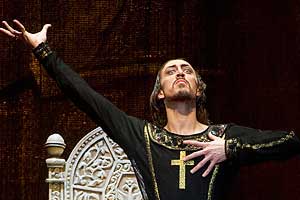
Ballet dancer Pavel Dmitrichenko confessed last week to hiring the men who threw acid in the face of Bolshoi Ballet director Sergei Filin in January.
Dmitrichenko was reportedly miffed that Filin repeatedly passed over his girlfriend, ballet prodigy Anzhelina Vorontsova, for leading roles. Why is the ballet such a big deal in Russia
It’s equal parts history, national pride and hero worship. Russians of all social strata have long been obsessed with dancing.
Regions have their own folk dances, and during the medieval period, dancing serfs provided the primary form of entertainment in the courts of Russian nobles. When the country became interested in Western European art forms in the late 17th and early 18th centuries, ballet replaced folk dances in the existing culture of dance training and performance.
Orphans of deceased government employees were raised from birth to be ballet dancers, and aristocrats founded ballet academies to train the serfs who occupied their lands.
The wealthy bought, sold and traded their most talented dancers.
There’s something uniquely Russian about the way the country went about conquering the ballet world: Russia’s mighty leaders decided to make ballet a Russian art form, and through centralized planning and the shrewd use of resources, bent the country’s culture to their will.
Catherine the Great, in particular, organized prestigious schools and built theatrical palaces. (It was Catherine who made the Bolshoi Russia’s most important ballet troupe.)
Russian czars used their wealth to coax foreign talent to St. Petersburg, especially after the French Revolution stalled artistic progress in Paris.
Most notably, the French dancer and choreographer Charles-Louis Didelot immigrated to Russia after finding it difficult to make a living in in London, which lacked a strong state sponsor of ballet.
Once in Russia, both foreign-born and native talent developed a Russian style of ballet. They helped liberate ballet from its relationship to opera – the world’s oldest national ballet troupe is known as the Paris Opera Ballet, founded in the 17th century – and focused on the beauty of the movement rather than a narrative structure.
In the early 20th century, Russian modernists like Sergei Diaghilev rebelled against the paint-by-numbers style of choreography that had turned ballet into a series of technical exercises.
While ballet lost popularity in Western Europe and the United States during the second half of the 20th century, it held on in Russia, in part because exporting world-class talent gave Russians enormous satisfaction.
The successors to Diaghilev’s Ballets Russes toured the world, spreading the gospel of ballet. (For a delightful account of this period, seek out Dan Geller and Dayna Goldfine’s 2005 documentary Ballets Russes.)
Ad Feedback
Young Russians saw the ballet as the quickest route to national and international glory, and the state strongly supported the development of promising dancers.
Today, ballet schools around the world boast that they teach in the Russian tradition, and Western trainees wonder how their Russian peers manage to bend themselves into improbable positions.
Russia’s unique style of ballet may also contribute to its enduring popularity. Many critics note – and some bitterly complain – that Russian dance troupes emphasize the individual dancers’ remarkable physical gifts, sometimes at the expense of subtlety and artistic expression.
Russian audiences demand such performances, loudly interrupting the ballet with cheers to celebrate feats of technical brilliance.
The emphasis on individual glory reminds one more of Hollywood’s star system than a purely artistic pursuit, and it may help to glamorize the ballet in modern Russia.
-Slate